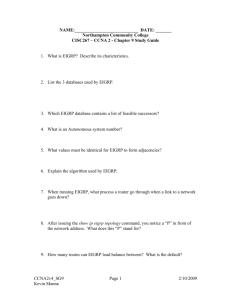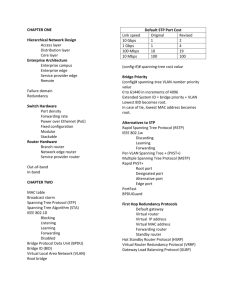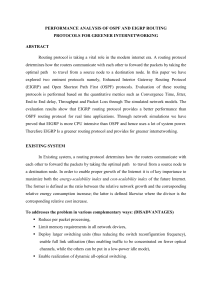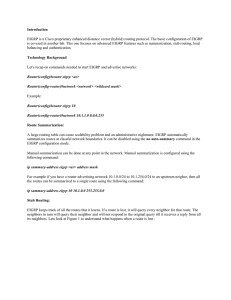CCNP BSCI Official Exam Certification Guide
advertisement
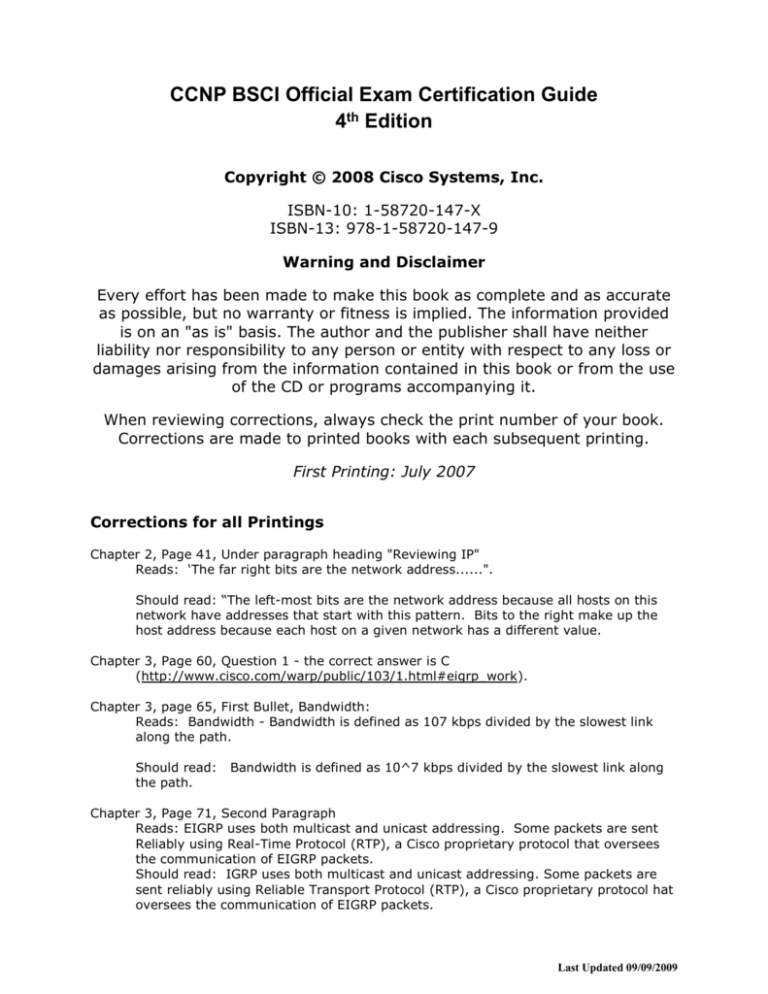
CCNP BSCI Official Exam Certification Guide 4th Edition Copyright © 2008 Cisco Systems, Inc. ISBN-10: 1-58720-147-X ISBN-13: 978-1-58720-147-9 Warning and Disclaimer Every effort has been made to make this book as complete and as accurate as possible, but no warranty or fitness is implied. The information provided is on an "as is" basis. The author and the publisher shall have neither liability nor responsibility to any person or entity with respect to any loss or damages arising from the information contained in this book or from the use of the CD or programs accompanying it. When reviewing corrections, always check the print number of your book. Corrections are made to printed books with each subsequent printing. First Printing: July 2007 Corrections for all Printings Chapter 2, Page 41, Under paragraph heading "Reviewing IP" Reads: ‘The far right bits are the network address......". Should read: “The left-most bits are the network address because all hosts on this network have addresses that start with this pattern. Bits to the right make up the host address because each host on a given network has a different value. Chapter 3, Page 60, Question 1 - the correct answer is C (http://www.cisco.com/warp/public/103/1.html#eigrp_work). Chapter 3, page 65, First Bullet, Bandwidth: Reads: Bandwidth - Bandwidth is defined as 107 kbps divided by the slowest link along the path. Should read: the path. Bandwidth is defined as 10^7 kbps divided by the slowest link along Chapter 3, Page 71, Second Paragraph Reads: EIGRP uses both multicast and unicast addressing. Some packets are sent Reliably using Real-Time Protocol (RTP), a Cisco proprietary protocol that oversees the communication of EIGRP packets. Should read: IGRP uses both multicast and unicast addressing. Some packets are sent reliably using Reliable Transport Protocol (RTP), a Cisco proprietary protocol hat oversees the communication of EIGRP packets. Last Updated 09/09/2009 Chapter 4, Page 90, Question 12, b Reads: debug ip eigrp packets Should read: debug eigrp packets Chapter 4, page 97, Figure 4-4 Reads: RouterB(config)#router eigrp 100 RouterB(config)#network 10.0.0.0. 255.0.0.0 RouterB(config)#eigrp stub Should read: RouterB(config)#router eigrp 100 RouterB(config)#network 10.0.0.0. 255.255.255 RouterB(config)#eigrp stub Chapter 4, Page 101, Reads: “EIGRP supports both clear text and MD5 authentication” Should read: “EIGRP supports authentication using MD5 hashes. Hashed keys, sent as MD5 values . . .” Chapter 4, page 102, Fifth Sentence: Should read: Finally, the key-chain is configured and the key is specified: router(config)#key chain chain-name router(config-keychain)#key key-id router(config-keychain-key)#key-string key An example configuration in AS 100 Should read: router(config-if)#ip authentication mode eigrp 100 md5 router(config-if)#ip authentication key-chain eigrp 100 my-chain router(config-if)#exit router(config)#key chain my-chain router(config-keychain)#key 1 router(config-keychain-key)#key-string secret. Chapter 4, Page 102, Page 109 and Page 111 Reads: router(config-if)#key chain chain-name router(config-if)#key key-id router(config-keychain-key)#key-string key Should read: router(config-if)#key chain chain-name router(config-keychain)#key key-id router(config-keychain-key)#key-string key Chapter 4, Page 109, in the table the first command: Should read: Newton #debug ip ei ? <1-65535> Autonomous System neighbor IP-EIGRP neighbor debugging notifications IP-EIGRP event notifications Last Updated 09/09/2009 summary IP-EIGRP summary route processing vrf Select a VPN Routing/Forwarding instance <cr> Newton #debug eigrp ? fsm EIGRP Dual Finite State Machine events/actions neighbors EIGRP neighbors nsf EIGRP Non-Stop Forwarding events/actions packets EIGRP packets transmit EIGRP transmission events Chapter 4, Page 111 the command is abbreviated to: Reads: “debug eigrp packet” Should read: “debug eigrp packets” Additionally in appendix A the command is also abbreviated in the answer to question 10 of the Q&A of chapter 4 and should also read as ‘debug eigrp packets’ Chapter 4, Page 118: Reads: RouterA(config)# router eigrp 63 RouterA(config)# no auto-summary RouterA(config)# network 10.0.0.0 RouterA(config)# int serial 0 RouterA(config-if)# ip summary-address eigrp 63 10.1.0.0 255.255.0.0 Should read: RouterA(config)# router eigrp 63 RouterA(config-router)# no auto-summary RouterA(config-router)# network 10.0.0.0 RouterA(config-router)# interface serial 0 RouterA(config-if)# ip summary-address eigrp 63 10.1.0.0 255.255.0.0 Chapter 5, Page 128, OSPF Snapshot, 2nd Paragraph last second sentence, Reads: It has a number of advantages over distance-vector protocols, including the following: Should read: It has a number of advantages of distance-vector routing protocols in general, including the following: Chapter 5, Page 134, Table 5-3, Last Column: Adjacencies Needed Using a DR and BDR: Reads: Should Read: 1 0 3 1 5 3 7 5 9 7 11 9 13 11 15 13 17 15 19 17 Chapter 6, page 170, Table 6-2: Change entries that say “Yes” to “manual” versus “dynamic” for ‘No”. Last Updated 09/09/2009 Chapter 6, page 171, First paragraph: Reads: On a Cisco router, it is possible to configure a physical interface with two logical subinterface options. You can configure these subinterfaces to be point-to-point or multipoint. (Note: The default OSPF network type for a physical serial interface is nonbroadcast multiaccess.) Should read: Cisco routers support frame-relay configuration on the physical interface or on point-to-point or point-to-multipoint logical subinterfaces. If subinterfaces are not used, the router will default to treating the frame-relay network as OSPF nonbroadcast multi-acess (NBMA). Chapter 7, Page 185, Question 22: Answer should be: A, C and D Chapter 10, Page 282, Question 2 Reads: Where is the Integrated IS-IS routing process started? Should read: Where is the Integrated IS-IS configuration commands entered? Chapter 11, Page 344, Last Paragraph: Reads: “To ensure the optimal path is chose, it is sometimes necessary to change the administrative distance. Te command structure is somewhat protocoldependent, in that EIGRP requires separate internal and external distances. The following command syntax is used for EIGRP: Should read: “To ensure the optimal path is chosen, it is sometimes necessary to change the administrative distance. The command to change the default administrative distance for EIGRP allows specifying internal and external distances. The E IGRP distance command is: Chapter 11, Page 345, First Line: Reads: “The distance command, as used to configure the EIGRP administrative distance, is explained in Table 11-6.” Should read: “The distance command, as used to configure the default EIGRP distance, is explained in Table 11-6. Chapter 11, Page 350, Example 2: Route Redistribution with Redundant Paths, second paragraph, last sentence Reads: Using RIP, network 140.100.1.0 is advertised to Router B, 140.100.3.0 is advertised to Router C and network 140.100.2.0 is advertised to both Routers A and B. Should read: Using RIP, network 140.100.1.0 is advertised to Router B, 140.100.3.0 is advertised to Router C and network 140.100.2.0 is advertised to both Routers B and C. Chapter 11, Page 353, Figure 11-11: Reads: EO: 190.10.10.10.1 Should read: EO: 190.10.10.1 Chapter 13, Page 383, Question 8: Reads: “Which of the following ports are forwarded by UDP by default?” Should read: “Which of the following UDP ports are forwarded when the ‘Ip helperaddress’ command is implemented.” Last Updated 09/09/2009 Chapter 15, Page 413, Question 9, answer b: Reads: “To clear the BGP routing table” Should read: “To clear the BGP table” Chapter 15, Page 416, First paragraph, First sentence Reads: The neighbor per-group-name command is used to create the peer group and to associate the peers with an AS. Should read: The neighbor per-group command is used to create the peer group and to associate the peers with an AS. Chapter 15, Page 421, First Paragraph, Third Sentence: Reads: “In this way, the router 10.10.35.8/29 is not seen in BGP updates because it is summarized into the 10.20.0.0/16 advertisement.” Should read: “In this way, the router 10.10.35.8/29 is not seen in BGP updates because it is summarized into the 10.10.0.0/16 advertisement.” Chapter 15, Page 431, Question 1: Reads: “How many sessions are active?” Should read: “How many neighbor sessions are established?” Chapter 16, Page 438, Question 10. Sixth and Ninth lines down: Reads: “set ip local preference 150 “set ip local preference 200 Should read: “set local preference 150” “set local preference 200” Chapter 16, Page 440, Question 11: Answer should be ‘c’ Chapter 18, Page 378, Question 2, Answer D: Reads: “Internet Group Membership Protocol” Should read: “Internet Group Management Protocol” Last Updated 09/09/2009 Chapter 16, Page 448, Example 16-5: Replace ‘IGP” with iGP Chapter 17, Page 461, Question 9: Answer should be: ‘a, b, and c” Chapter 17, Page 462, Question 10: Answer should be: ‘b and c’ Chapter 18, Page 484, Third Sentence Reads: In version 2, all routers start as queriers and transition to non-queriers of they hear another querier with a higher IP address. Should read: In version 2, all routers start as queriers and transition to non-queriers of they hear another querier with a lower IP address. Foundation Summary, Page 489, Second to last bullet: Reads: Querier election occurs-all routers start as queriers and transition to non– queriers if they hear another querier with a higher IP address. Should read: Querier Elections - All routers start as queriers and transition to non–queriers if they hear another querier with a lower IP address. Appendix A, Chapter 2, Page 574, Answer 7 Reads as: "24.177.78.62/27 includes 24.177.78.33 - 63" Should read: "24.177.78.62/27 includes 24.177.78.33 - 62" Appendix A, Chapter 4, Page 578, Answer 10 of the Q&A: Should read: ‘debug eigrp packets’ Appendix A, Chapter 7, Page 583, Answer 11 of Do I Know This Already: Should read: A and C Appendix A, Chapter 9, Page 590, Answer 14 of Do I know This Already: Should read: A, B, and D Appendix A, Chapter 11, Page 597, Answer 10 of Do I know This Already: Should read: D Appendix A, Chapter 17, Page 609, Q&A, Answer 7: Reads: All routers start as queriers and transition to non-queriers if they hear another querier with a higher IP address. Should read: All routers start as queriers and transition to non-queriers if they hear another querier with a lower IP address. Errata for CD: QID 150 on CD: Answer to question Question: Which command is used to establish the default or seed metric for EIGRP? Answer Reads: C. Default-metric bandwidth delay reliability loading mtu eigrp Answer Should Read: Default-metric bandwidth delay reliability loading mtu Last Updated 09/09/2009 This errata sheet is intended to provide updated technical information. Spelling and grammar misprints are updated during the reprint process, but are not listed on this errata sheet. Last Updated 09/09/2009

